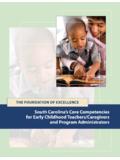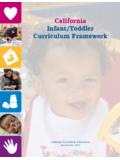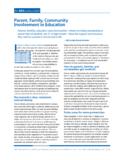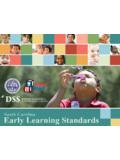Transcription of Keep Flu out of School - Prevent Childhood Influenza
1 Keep Flu out of SchoolOverview of the Influenza (Flu)How to Use This E-toolkit What s in the E-toolkitWhy Should You Care About FluQuick Flu FactsKeep Flu out of School Program: Success StoriesHow to Increase Vaccination UptakeSocial and Digital Media TipsVisual ToolsTips for Overcoming Common BarriersEveryday Actions to Prevent the Spread of FluResourcesReferencesHow to Rally Support from #KFOSWhy Should You Care About Flu?Why Should You Care About Flu?Why Should You Care About Flu?Keep Flu out of School E-toolkitKeep Flu out of School is a School -based program designed to raise awareness about the burden of Influenza (flu) and the benefits of annual vaccination. The long-term outcomes of the project are to: ensure that elementary School children receive an annual Influenza vaccination; reduce Childhood immunization barriers; and, ultimately increase Influenza vaccination coverage rates among children in elementary School grades e-toolkit offers numerous resources for School nurses and teachers that can be used to raise awareness about the burden of Influenza and the benefits of annual vaccination.
2 These resources can also be shared with parents and caregivers as a way to educate local communities about e-toolkit was developed as part of the Keep Flu out of School program under an educational grant from the Centers for Disease Control and Prevention (CDC). Keep Flu out of School is a School -based program designed to promote, strengthen, and enhance Flu prevention efforts among elementary School students, their parents, and teachers. The resources herein are intended to complement existing health-related curriculums for elementary School watch this short video that illustrates why flu prevention is so important, especially for School -aged to Action: Targeted motivational video why to implement KFOS. Click here for video transcriptWhat s in the E-toolkitHow to Use the E-toolkitOverview of FluTable of ContentsWhat s In The E-toolkitClick on image to view videoWhy Should You Care About Flu?
3 Why Should You Care About Flu?What s In The E-toolkitClick on the links below to find numerous resources that can help you implement a flu prevention education program in your elementary School . Quick Flu Facts Sample letter for principals Checklist for Keep Flu out of School Program Planning How to identify champions and rally support Guidelines for a poster contest Tips for using social media Tips for overcoming barriers Tips to share with teachers Resources for teachers to use Resources to share with parentsWhy Should You Care?How to Use the E-toolkitOverview of FluTable of ContentsHow to Use this E-toolkitto Keep Flu out of SchoolBefore You Get Started (May- August) Use the Sample letter To Principal to gain administrative support to implement a flu prevention education program in your elementary School .
4 Join the online community of School nurses interested in flu prevention to share best practices (free registration is required). Review Getting Started - Tips for Seasonal Flu Awareness program. Identify key champions and invite their participation. Consider including classroom teachers, health assistants, School administrators, parents/guardians, students and other School specific support staff. Contact community stakeholders to enlist their support in your School efforts (see Stakeholder section)During Program Implementation Start early in the School year to engage teachers, administrators and parents/guardians in the planning. Visit the KFOS website for available resources Download and print resources that make sense for your School community.
5 Garner School support of flu prevention education by sharing the Freddie the Flu Detective Public Service Announcement with teachers, parents/guardians, and students. Watch on YouTube or embed the video on your site. Consider ways to highlight the vaccine focus in your School community during key time periods such as at the beginning of School , before flu is reported in your community and once flu is circulating. Provide a list of locations that offer flu vaccination and link to HealthMap Vaccine Finder. Develop and implement a plan to promote the KFOS program throughout the School year. See an example calendar for KFOS implementation. Wrapping Up the Year Determine how to evaluate and revise your plan to improve next year. Share lessons learned with School administrators and key decision Flu FactsOverview of Seasonal Influenza (Flu)Both teachers and parents report preferring hard copies of materials.
6 Be sure to download and print copies of resources for teachers to use in the classroom and information to send home with s in the E-toolkitOverview of FluTable of ContentsUse the navigational buttons at the bottom of each page to move from one page of the toolkit to another. Click on the blue underlined words to access hyperlinks to additional of Seasonal Influenza (Flu) Influenza , also called flu, is among the leading causes of preventable morbidity and mortality. In fact, flu causes more deaths than any other vaccine-preventable disease (CDC, 2016a).Approximately 20,000 hospitalizations and nearly 100 deaths occur each year in children under the age of five (CDC, 2017). Flu can be a serious illness and each flu season is unpredictable. The single best way to protect against flu and its potentially severe complications is to get a seasonal flu vaccine each year.
7 The CDC recommends that everyone 6 months of age and older get a seasonal flu vaccine each year, preferably before the end of October. How to Use the E-toolkitQuick Flu FactsSuccess StoriesTable of ContentsWhy is a flu vaccination is needed each year? The flu virus changes each year. And because the vaccine changes to match the circulating flu virus each year, each year s vaccine could be different from the last. In addition, immune protection from the flu vaccine declines over time, so getting a vaccine every year is the best way to stay nurses are important influencers and as such, an annual flu campaign directed by the School nurse is very important to maintain healthy School StakeholdersSuccess StoriesOverview of FluTable of ContentsQuick Flu Facts Influenza , also called flu, is a contagious viral infection of the nose and throat.
8 Flu can spread easily through coughing and sneezing. Flu can cause secondary complications such sinus and ear infections and pneumonia or make chronic medical conditions like asthma worse. (CDC, 2016b) The flu is a serious disease; much more dangerous than the common cold for children. The best way to protect children from flu is to get them vaccinated each year. Anyone can get sick with flu Every year in the United States: Flu results in approximately 20,000 hospitalizations in children younger than 5 years of age (CDC, 2017a) On average, 100 children die from flu; many of whom were otherwise healthy (CDC, 2017b; Flannery et al., 2017). On average in the United States, children miss approximately 38 million School days every year due to flu (Adams et al.)
9 , 1999). Flu is not the same as the stomach flu, which is a viral infection of the stomach and intestines that will typically goes away on its own within a few days. Most pediatric flu deaths since 2004 have occurred in unvaccinated children; therefore, increasing flu vaccination rates among children and adolescents could Prevent flu-associated deaths (Flannery et al., 2017). Keep Flu Out of School Program: Success StoriesQuick Flu FactsSuccess Stories cont dTable of ContentsKeep Flu Out of School Program: Success StoriesSpringfield Public Schools: Expanding Reach and Impact to Prevent Flu and Improve Student Vaccination Rates through the Keep Flu out of School ProgramSPS Approach to KFOS ImplementationKFOS Impacts on Flu Prevention and Student Vaccination RatesSpringfield Public Schools (SPS) in Springfield, Missouri benefits from strong School nurse leadership, a School -located vaccination (SLV) clinic, and a low School nurse-to-student ratio of one nurse for approximately 400 students.
10 The National Association of School Nurses (NASN) and partner organizations approached SPS School nurse leadership in 2014 about becoming a pilot site for Keep Flu out of School (KFOS), a program funded by the Centers for Disease Control and Prevention. SPS met School site selection criteria for KFOS implementation, such as its location in a state with reported Influenza vaccine uptake of less than 50 percent and a low-income community, while having internal capacity and resources for improvement. SPS viewed it as an important opportunity to expand their reach by increasing awareness of flu prevention and flu vaccination rates among elementary students and their families and has since demonstrated how building on a district s existing resources with educational materials provided through KFOS can be a highly effective approach to protecting students and their families against the implement KFOS, SPS School nurses worked closely with four elementary schools.






